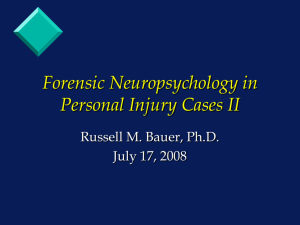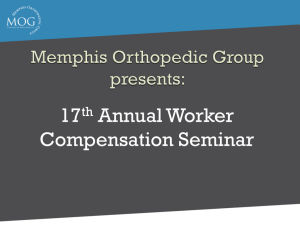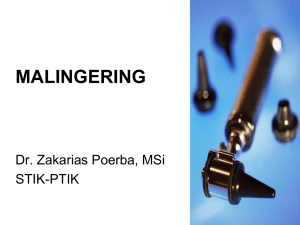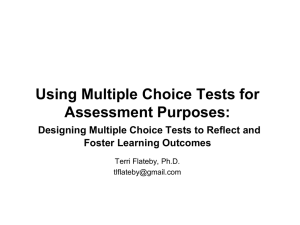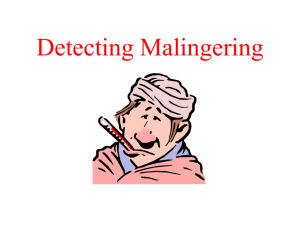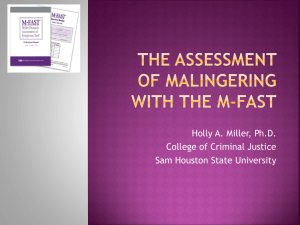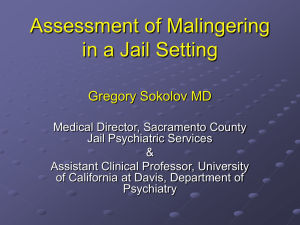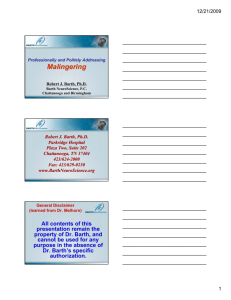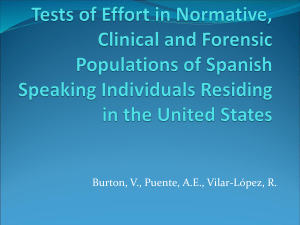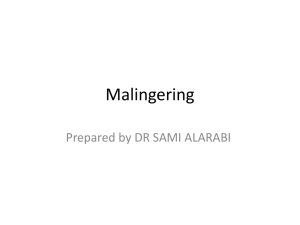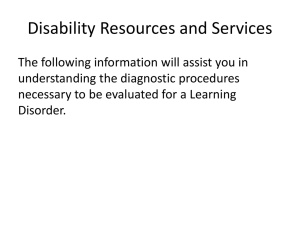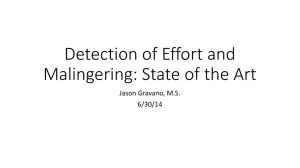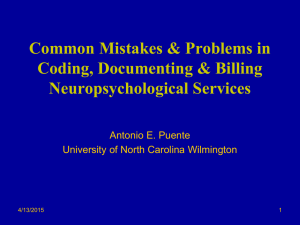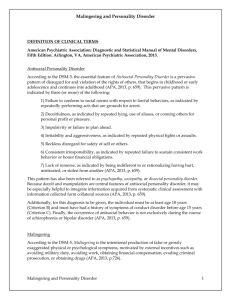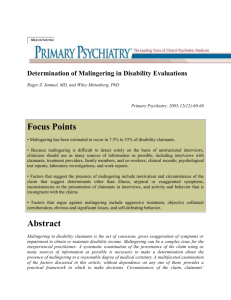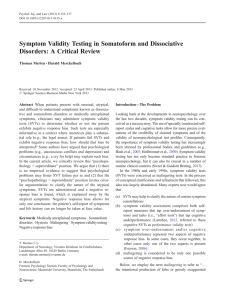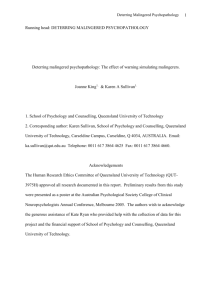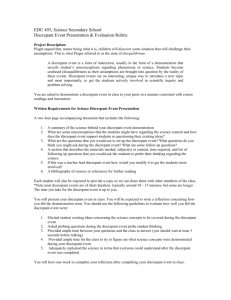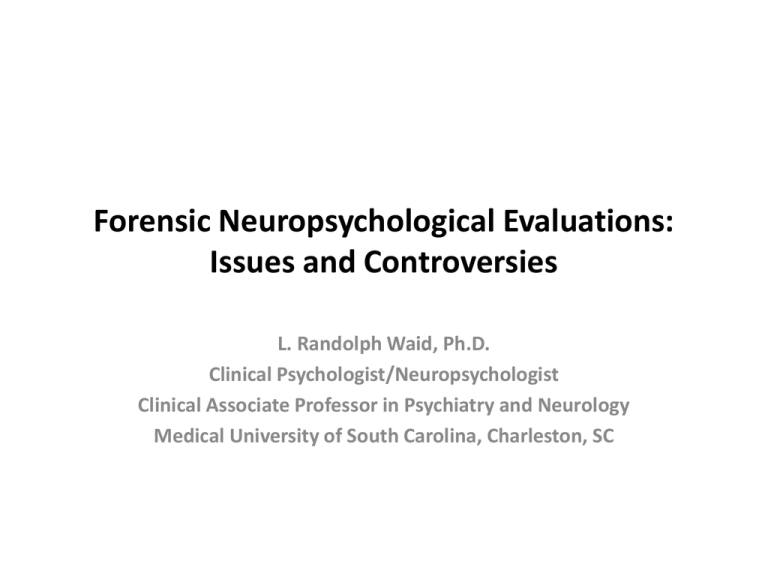
Forensic Neuropsychological Evaluations:
Issues and Controversies
L. Randolph Waid, Ph.D.
Clinical Psychologist/Neuropsychologist
Clinical Associate Professor in Psychiatry and Neurology
Medical University of South Carolina, Charleston, SC
I. Evaluation of Testing Effort/Malingering
Malingering: The diagnostic and Statistics Manual of Mental
Disorders, Fourth Edition (1994) defines malingering as, “…the
intentional production of false or grossly exaggerated physical or
psychological symptoms, motivated by external incentives such
as avoiding military duty, avoiding work, obtaining financial
compensation, evading criminal prosecution, or obtaining
drugs.” p. 683
Malingering can occur in one of three patterns in
neuropsychological settings:
(A) false or exaggerated reporting of symptoms
(B) intentionally poor performance on neuropsychological
tests
(C) a combination of symptom exaggeration and
intentional performance deficit
Significant increase in research on developing
specialized procedures to detect malingering include:
(A) Stand alone tests/symptom validity tests
(B) Patterns of malingering on standard clinical tests
(C) Fabrication and exaggeration of symptoms on
psychological measures/validity scales
Properties of a good stand alone test (Hartman, 2003)
• Measure willingness to exert basic effort and are insensitive to the
cognitive dysfunction being assessed (sensitivity and specificity).
• Appear to the patient to be a realistic measure of the cognitive modality
under study (face validity).
• Measure abilities that are likely to be exaggerated by patients claiming
brain damage.
• Have a strong normative basis underlying test results to satisfy scientific
and Daubert concerns.
• Are based on validation studies that include normals, patient populations
and individuals who are suspected and/or verified malingerers in actual
forensic or disability assessment conditions.
• Should be difficult to fake or coach.
• Should be relatively easy to administer.
• Are supported by continuing research.
Stand Alone Tests/Symptom Validity Test
•
•
•
•
Test of Memory Malingering (TOMM)
Word Memory Test
Validity Indicator Profile
Structured Interview of Reported Symptoms-II (SIRS-II)
Formulas using Existing Tests
• Digit Span Test (Reliable Digit Span)
• Measures on Recognition Memory (CVLT-II)
• Measures of Problem Solving Ability
Detection of Symptom Exaggeration
Minnesota Multiphasic Personality Inventory-II
• F family of scales
F, Fb, F (p)
• FBS scale
Detection of Cognitive Malingering (Slick et al 1999)
• A multi-dimensional approach
• Malingering vs. Less than optimal testing effort
• Consideration of evidence from neuropsychological testing
and self report
Detection of Cognitive Malingering
• Evidence from Neuropsychological Testing includes:
(A) Definite negative response bias
(B) Probable response bias
Detection of Cognitive Malingering
• Evidence from Neuropsychological Testing also includes:
(A) Discrepancies between test data and patterns of
brain functioning
(B) Discrepancies between test data and
observed behavior
(C) Discrepancies between test data and reliable
collateral reports
(D) Discrepancies between test data and
documented background history
Detection of Cognitive Malingering
• Evidence from self report includes:
(A) Self report history discrepant with documented
history
(B) Self reported symptoms discrepant with known
patterns of brain functioning
(C) Self reported symptoms discrepant with
behavioral observations
(D) Self reported symptoms discrepant with
information obtained from collateral informants
(E) Also includes evidence of exaggerated or
fabricated psychological dysfunction on well
validated validity scales (e.g. MMPI-2)
Definite Malingering
• Presence of a substantial external incentive (Criterion A).
• Definite negative response bias (Criterion B).
• Behaviors meeting necessary criteria from group B are not
fully accounted for by psychiatric, neurological, or
developmental factors (Criterion D).
II. Estimating Pre-morbid Intelligence
• Obtainment of previous educational records including
standardized Educational test scores/military records, etc.
• Level of educational/occupational attainment
• Current test results
• The problem of above and below average intelligence
Estimating Premorbid Intelligence
• Four general methods used to estimate premorbid IQ
(A) The best performance method
(B) Subject’s performance on intelligence subtests that
are thought to be relatively insensitive to the effects of brain
damage (e.g. vocabulary, information)
(C) Tests of overlearned skills such as reading which are
highly correlated with intelligence (e.g. NART, WRAT-4, WTAR)
(D) Actuarial methods that use demographic data such as
age, sex, race, education, and occupation to estimate premorbid
IG (e.g. Barona Index)
(E) WAIS-IV Advanced Clinical Solutions
Mild Traumatic Brain Injury
• Accounts for 72% of all traumatic brain injury
• The issues of the incidence, cause, and persistence of
deficits following MTBI remains controversial
• Iraq war veterans and sports psychology/NFL
• Recent research-Simple blood test to identify mild
brain trauma
• New research on higher resolution imaging
Mild Traumatic Brain Injury
• Diagnosing
(A) Direct observation
(B) Retrospective determination
Mild Traumatic Brain Injury
• Definition (ACRM 1993)
1. Any period of loss of consciousness
2. Any loss of memory for events immediately before or
after the accident
3. Ant alteration of mental state at the time of the
accident (e.g. feeling dazed, disoriented, or confused)
4. Focal neurological deficit(s) that may or may not be
transient
5. Exclusion Criteria
6. Compared to DSM-IV diagnosis
Acute Symptoms of MTBI
•
•
•
•
Nausea
Vomiting
Blurred vision
Somnolence
Symptoms of Post-Concussive Syndrome (PCS)
•
•
•
•
•
•
Headaches
Fatigue
Insomnia
Irritability
Emotional lability
Anxiety
Is a concussion the same as
a Post-Concussive Disorder
•
•
•
•
•
•
Depression
Photosensitivity
Dizziness
Attentional Problems
Memory Deficits
Intolerance to alcohol
Can We Rely on Objective Evidence?
• Neuroimaging – CT and MRI Scans
Diffuse axonal injuries possibly associated with MTBI
are typically not visible on static neuroimaging.
• PET and SPECT Scans
• EEG/Brain Mapping and Computerized EEGs
Mild Traumatic Brain Injury
Post-concussion Disorder refers to somatic, cognitive
and emotional residuals that should be classified as
follows:
• Acute: lasting up to one month post-injury
• Sub-acute: lasting greater than one month and less
than 12 months
• Chronic: duration greater than one year
Cultural/Language Differences
• The Hispanic brain damaged worker
• How to evaluate
1. Review the physics of the accident; the acute
neurological sequelae; neuroradiographic
studies; and emergent medical records most
important.
• Neuropsychological testing is a sampling of behaviors but
lacks validity due to language/cultural differences.
• Use of translator and Spanish version of tests
• The value of a neuropsychological evaluation

